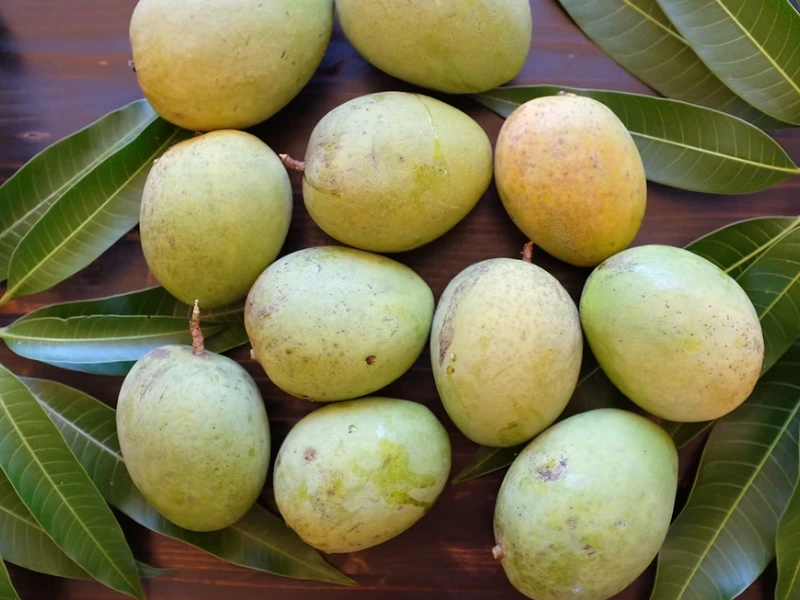Imagine stepping into your backyard and plucking a juicy, sweet mango straight from the tree. But not just any mango – a Cotton Candy Mango. Known for its incredibly sweet and unique flavor, the Cotton Candy Mango Tree is perfect for both beginners and seasoned gardeners who want to grow their own tropical fruit at home. If you’re in the USA, especially in regions with a warm climate, this tree is a fantastic addition to your garden.
In this article, I’ll guide you through everything you need to know about growing and caring for a Cotton Candy Mango Tree, from planting to harvesting. Whether you’re in California, Florida, or any other warm part of the country, you can easily grow this delicious tree. Let’s dive into the details!
Read more: Cold Hardy Mango Trees: Best Varieties and Growing Tips for Cooler Climates
What is the Cotton Candy Mango Tree?

The Cotton Candy Mango Tree, a variety of Mangifera indica, is one of the sweetest mango varieties available. Its signature flavor resembles the light, sugary sweetness of cotton candy, making it a favorite among mango lovers. This mango variety has a distinctively smooth texture and an aromatic scent that’s hard to resist.
Key Features:
-
Flavor: Unlike the common mango, the Cotton Candy Mango has a mild, delicate, and sugary flavor, with less of the tang you typically associate with mangoes.
-
Size: The Cotton Candy Mango Tree is compact compared to other mango varieties, typically growing to around 10-15 feet tall. This makes it ideal for home gardens, even those with limited space.
-
Climate: Native to tropical and subtropical regions, the tree thrives in warm climates. In the U.S., this tree is best suited for regions such as Florida, southern Texas, Southern California, and parts of Arizona.
Planting the Cotton Candy Mango Tree

Planting a Cotton Candy Mango Tree requires proper planning and care. If you’re considering adding one to your garden, here’s a step-by-step guide to getting started.
Best Time to Plant the Cotton Candy Mango Tree:
-
The best time to plant your Cotton Candy Mango Tree is during the spring or early summer months, ideally after the last frost. This ensures that the tree will have ample time to establish itself before cooler weather sets in.
-
In the southern U.S., you can plant it as early as February, while in northern regions, waiting until May or June is recommended.
Choosing the Right Location:
-
Sunlight: Mango trees require a lot of sunlight to thrive. Choose a location that receives full sun for at least 8-10 hours per day.
-
Space: Ensure that the location allows enough room for the tree to grow to its full size. While the Cotton Candy Mango Tree isn’t massive, it still needs space to spread its roots and canopy.
-
Protection: Mango trees don’t do well with strong winds, which can damage both the tree and its fruit. Planting the tree near a natural windbreak or using a protective barrier may help.
Soil Preparation:
-
Mango trees prefer well-drained soil with a slightly acidic pH (around 5.5 to 7.5).
-
If your soil has a high clay content, amend it with organic matter like compost or coconut coir to improve drainage. This will prevent water from pooling around the roots and causing rot.
-
Tip for Southern U.S. gardeners: If you’re in an area with sandy soil, you might need to add organic matter to boost the soil’s fertility and structure.
Planting the Cotton Candy Mango Tree:
-
Dig a hole that is about twice as wide and deep as the root ball. This gives the roots plenty of space to spread out.
-
After placing the tree in the hole, make sure the top of the root ball is level with the ground surface. Backfill the hole with soil, gently packing it to remove air pockets.
-
Water the tree generously after planting to help settle the soil.
Container Planting Tips:
-
If you’re in a region with cold winters, container planting is a great option. You can move the tree indoors during colder months.
-
Choose a large, sturdy pot with good drainage, and use a mix of well-draining potting soil and organic matter.
-
Ensure the container allows for growth by repotting the tree every 2-3 years as it matures.
Growing the Cotton Candy Mango Tree

Once your Cotton Candy Mango Tree is planted, there are a few essential things to keep in mind to help it grow strong and healthy.
Watering:
-
Mango trees don’t like to stay wet. Over-watering can lead to root rot, so ensure the soil has good drainage.
-
During the summer months, water deeply once every 7-10 days, allowing the soil to dry out between waterings.
-
Winter Care: In colder months, reduce watering to once every 2-3 weeks as the tree goes into dormancy.
Fertilizing:
-
Apply a slow-release fertilizer formulated for fruit trees in early spring when the tree is starting to grow.
-
In the summer, you can add a balanced liquid fertilizer to encourage new growth. Ensure you follow the instructions on the fertilizer packaging to avoid over-fertilizing, which can damage the tree.
Pruning or Pinching:
-
Prune your tree regularly to remove any dead, damaged, or diseased branches. This will help maintain the tree’s shape and promote better airflow and sunlight penetration.
-
Pinching back the tips of young branches encourages the tree to grow more branches, leading to a bushier tree with more potential fruit.
Seasonal Plant Care Tips:
-
In the cooler months, you can either bring container-grown trees indoors or use a frost cloth to protect outdoor trees from frost damage.
-
Tip for Southern gardeners: During periods of high humidity, watch out for fungal infections like powdery mildew. If you notice white spots on the leaves, treat the tree with a mild fungicide.
Potting and Repotting:
-
If growing in a container, repot your tree every 2-3 years to avoid root overcrowding. Always choose a pot that is slightly larger than the previous one.
How to Propagate the Cotton Candy Mango Tree
Mango trees are typically propagated via grafting, which helps preserve the quality of the fruit. However, you can also propagate them from seeds.
Seed Propagation:
-
Extract the seed from a ripe Cotton Candy Mango, clean it thoroughly, and allow it to dry for a few days.
-
Plant the seed in a small pot with a well-draining potting mix. It might take a few weeks for the seed to sprout.
Grafting:
-
Grafting is a more common method of propagation for the Cotton Candy Mango Tree. This involves joining a cutting from a mature tree to a rootstock. Grafting ensures that the tree will bear fruit quicker and will have the same fruit quality as the parent tree.
How to Get the Cotton Candy Mango Tree to Bloom

Mango trees typically bloom in late spring or early summer. Here’s how to encourage your Cotton Candy Mango Tree to bloom.
When to Bloom:
-
Mango trees usually bloom just before the fruit develops. The blooming period typically lasts 2-4 weeks and occurs after a dry period.
How to Get the Tree to Bloom:
-
If you live in an area without a dry season, try reducing watering for a few weeks to mimic dry conditions. This can trigger the tree to bloom.
-
Mango trees need to be in optimal health to bloom. Ensure they are well-fed, have enough sunlight, and are pruned properly.
Harvesting and Storing Cotton Candy Mangoes

Once your mangoes begin to ripen, it’s time to harvest.
When to Harvest:
-
Cotton Candy Mangoes are ready to harvest when they are golden yellow, and the skin has a slight give when gently squeezed.
-
Timing: Harvest typically occurs in late summer or early fall, depending on your location.
How to Harvest:
-
Use a sharp knife or pruning shears to cut the fruit from the tree, leaving a small portion of the stem attached.
-
Handle the fruit gently to avoid bruising. Mangoes can be eaten fresh, or you can store them in a cool, dry place for a few days to ripen further.
Troubleshooting Cotton Candy Mango Tree Care

While Cotton Candy Mango Trees are relatively easy to grow, they can face challenges.
Problems:
-
Poor Growth: This could be due to poor soil, lack of sunlight, or incorrect watering. Check the tree’s environment and adjust care practices as necessary.
-
Yellow Leaves: This may indicate over-watering, a nitrogen deficiency, or other nutrient imbalances.
Pests/Diseases:
-
Mango Weevils: These pests are common in mango trees. If you spot them, treat the tree with organic pesticides like neem oil.
-
Powdery Mildew: This fungus thrives in humid conditions. Ensure proper air circulation and treat infected areas with a fungicide.
FAQs About the Cotton Candy Mango Tree
-
Can I grow a Cotton Candy Mango Tree indoors?
-
Yes, as long as you provide enough sunlight and maintain proper watering and fertilizing schedules.
-
-
How long does it take for the Cotton Candy Mango Tree to bear fruit?
-
If propagated from seed, it can take around 5-8 years to bear fruit. With grafting, fruiting may begin in as little as 2-3 years.
-
-
How big does a Cotton Candy Mango Tree grow?
-
Typically, the tree reaches 10-15 feet in height, making it manageable for home gardens.
-
-
Can I grow a Cotton Candy Mango Tree in colder climates?
-
It’s best suited for tropical and subtropical climates, but container planting allows you to move the tree indoors during winter.
-
Final Thoughts
Growing a Cotton Candy Mango Tree is a rewarding experience that can bring a tropical touch to your backyard. Whether you live in a warm, sunny region or need to grow your tree in a pot, this tree is a fantastic choice for gardeners in the USA. By following the tips above, you’ll be on your way to enjoying sweet, home-grown mangoes in no time. Happy gardening!
